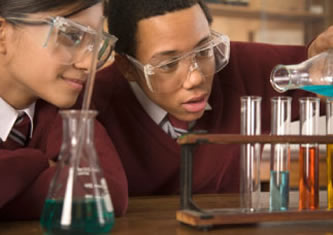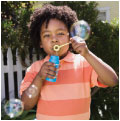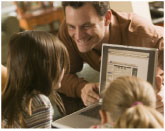 |
|
 |

Learning by Asking: Investigating Science Through Inquiry What do blowing bubbles from different soap solutions, dropping an apple into a tub of water, and examining a U.S. Department of Agriculture food pyramid all have in common? These activities are all examples of Investigating Science Through Inquiry, one of the promising practices in the science section of the Afterschool Training Toolkit. Inquiry is grounded in asking questions, making predictions, and testing those predictions. For example, in the above situations, you may ask, “What brand of dish soap produces the biggest bubbles? What determines whether an object will sink or float? How nutritious is the food served in the school cafeteria?” Once you have posed a question, consider an experiment that will let students discover the answer by investigating, observing, collecting and analyzing data, and communicating results. As students begin the process of scientific inquiry in afterschool, many of the first investigations will be more instructor-directed. As students learn the process, they can be more self-directed. The Afterschool Training Toolkit can provide guidance on determining how self-directed your students are and what a scientific inquiry might look like based on their level of independence. Investigating Science Through Inquiry works because students are directly involved in their own learning—questioning, observing, recording and analyzing data, reflecting on their findings, and sharing those findings with others. Students develop cognitive abilities—critical thinking and reasoning skills—as well as science understanding. If you would like to see an example of scientific inquiry in action in an afterschool program, go to the Investigating Science Through Inquiry practice of the science section of the toolkit and click on the video. If you think your afterschool students might be interested in exploring questions related to bubbles, water, or food pyramids, click on the "Sample Lessons" tab to explore the lessons. |
|

| 
THE CONSUMER'S GUIDE TO AFTERSCHOOL
SCIENCE RESOURCES
This free resource contains reviews of high-quality, hands-on science content for afterschool programs. It has been updated recently to include reviews of 15 additional curricula, including reviews of materials for afterschool leaders seeking information about offering science activities in their afterschool programs. |

|
Vision Education & Media
|
 |
 |
 |
|
Safety First |
|
|
This email was sent by: Editor: Laura Shankland This newsletter was produced
in whole or in part with funds from the U.S. Department of Education
under contract number You are welcome to reproduce issues of AfterWords and distribute copies at no cost to recipients. Please credit SEDL as publisher. Link to PDF versions of AfterWords is available here. For additional uses, please fill out and submit a copyright request form. Copyright © 2008 by SEDL. |



